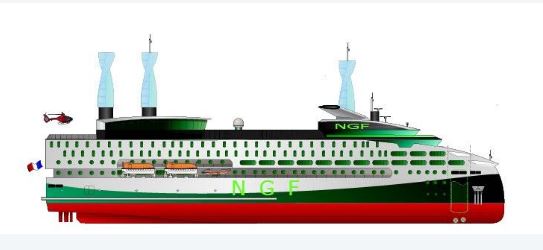NGF pauses ferry project and shifts its focus to environmentally friendly cruise ships.

The cruise ships, of approximately 140metres and 500 passengers, have been designed to fit into all quays in the port of Nice as well as other small ports in the wider Mediterranean Sea where several well-known and popular ports/destinations have already contacted NGF to express interest.
Nice Green Ferries (NGF) have, for several years, worked on two projects simultaneously: environmentally friendly RoPax cruise ferries and medium-sized luxury cruise ships. The focus has been on establishing certain agreements with the port of Nice/CCI concerning the design parameters for two new zero emission 135metre RoPax ferries, which would have their base in Nice and run daily routes to Corsica and Sardinia. Also in discussion, has been the operational requirements and environmental constraints of the ships which are to be built in a European shipyard and planned to be in operation by 2024/2025.
Without any immediate political support or signed agreement from the owners of Nice Port (CCI/Metropole), NGF cannot currently secure the financial support required for this project and have for this reason, decided to pause the RoPax ferry initiative. Instead, NGF will re-align and focus on the second part of the project – the luxury cruise ships.
The cruise ships, of approximately 140metres and 500 passengers, have been designed to fit into all quays in the port of Nice as well as other small ports in the wider Mediterranean Sea where several well-known and popular ports/destinations have already contacted NGF to express interest.
The two planned cruise ships have capacity to operate all year around from the port of Nice, with itineraries of 3, 4, 7 and 14 days. The ships will be built with modern shallow water hulls and run on several environmentally friendly multi-fuels:
- Clean Diesel oil
- Hydrogen as available. (The ships are prepared for Hydrogen).
- Large size batteries chargeable by Renewable Energy from sun and wind
- Solar panels
- Windmills
In addition, no shore power will be required. The engines will be shut down whilst in the ports and the ships can embark with zero emission by using batteries only, or hydrogen if required. Furthermore, when the cruise ships are within a three-kilometer radius of any coast, they will run on zero emission by using renewable energy.
​The cruise ships have been designed with the goal to be the most environmentally friendly ships ever built. NGF have never considered using liquified natural gas (LNG) as a main fuel because the Methanol produced by such exhausts is 20 times more dangerous for the environment than CO2 and even though other projects are starting to “clean” LNG, it can never be emission free.
Other reasons to avoid LNG:
- Large and expensive tanks/hull spaces
- High installation cost
- Very expensive LNG
- Problem with fuelling in the ports
The cruise industry has, according to recent press releases, encountered financial problems with subsequent sharply falling share values. This may be due to many reasons including heavy loans, the knock-on effect of Covid-19, airport issues, inflation, etc. Moreover, the larger cruise ships holding up to 6000 passengers, have not been designed to be sufficiently environmentally friendly and may soon be prohibited from using several ports. This includes the most recent ships delivered and launched.
On this basis, smaller and environmentally superior cruise ships may have a more successful future and NGF is pioneering this idea with their cruise ship project.
Nice, and the Cote d’Azur, is a well-known and popular luxury travel destination with continuous and thriving tourism all year around. With operations from Nice, NGF believes the demand and market is already there for this project.
